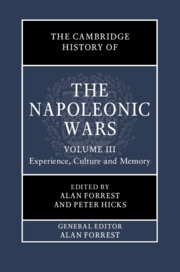Book contents
- The Cambridge History of the Napoleonic Wars
- The Cambridge History of the Napoleonic Wars
- The Cambridge History of the Napoleonic Wars
- Copyright page
- Contents
- Figures
- Maps
- Contributors to Volume III
- Introduction to Volume III
- Part I The Experience of War
- Part II The Experience of Imperial Rule
- Part III War, Culture and Memory
- 12 Memoirs and the Communication of Memory
- 13 Festivals, Ceremonies and Public Commemorations
- 14 The Portrayal of Heroism
- 15 The Fine Arts and the Napoleonic Wars
- 16 Poets and Novelists: Writing the Memory of War
- 17 Political Keyboard Music in Revolutionary and Napoleonic France: ‘The Battle’
- 18 The Napoleonic Wars in Caricature
- 19 The Napoleonic Wars in European Cinema
- 20 Nostalgia, or a Ruin with a View
- Part IV The Aftermath and Legacy of the Wars
- Bibliographic Essays
- Index
18 - The Napoleonic Wars in Caricature
from Part III - War, Culture and Memory
Published online by Cambridge University Press: 05 August 2022
- The Cambridge History of the Napoleonic Wars
- The Cambridge History of the Napoleonic Wars
- The Cambridge History of the Napoleonic Wars
- Copyright page
- Contents
- Figures
- Maps
- Contributors to Volume III
- Introduction to Volume III
- Part I The Experience of War
- Part II The Experience of Imperial Rule
- Part III War, Culture and Memory
- 12 Memoirs and the Communication of Memory
- 13 Festivals, Ceremonies and Public Commemorations
- 14 The Portrayal of Heroism
- 15 The Fine Arts and the Napoleonic Wars
- 16 Poets and Novelists: Writing the Memory of War
- 17 Political Keyboard Music in Revolutionary and Napoleonic France: ‘The Battle’
- 18 The Napoleonic Wars in Caricature
- 19 The Napoleonic Wars in European Cinema
- 20 Nostalgia, or a Ruin with a View
- Part IV The Aftermath and Legacy of the Wars
- Bibliographic Essays
- Index
Summary
In order to glorify his reign through propaganda, Napoleon utilised, among other sources, iconography. In particular, the images which he conceived or whose diffusion he favoured concentrated on his grandeur; the republican general turned emperor encouraged works that showcased his military acumen, his courage, or his scientific approach to combat or, by contrast, images that highlighted his magnanimous and peaceful nature. He thus became, ‘the father of his people’, like the monarchs of the Old Order, alternately the attentive and benevolent father of the family or its military leader. These images constantly edified, constructed, and reinvented his authority; they made explicit his ‘brilliant’ persona, but, as well, the state he led.
- Type
- Chapter
- Information
- The Cambridge History of the Napoleonic Wars , pp. 373 - 394Publisher: Cambridge University PressPrint publication year: 2022

